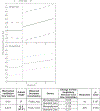Micropatterned Endotracheal Tubes Reduce Secretion-Related Lumen Occlusion
- PMID: 27535564
- PMCID: PMC11949081
- DOI: 10.1007/s10439-016-1698-z
Micropatterned Endotracheal Tubes Reduce Secretion-Related Lumen Occlusion
Abstract
Tracheal intubation disrupts physiological homeostasis of secretion production and clearance, resulting in secretion accumulation within endotracheal tubes (ETTs). Novel in vitro and in vivo models were developed to specifically recapitulate the clinical manifestations of ETT occlusion. The novel Sharklet™ micropatterned ETT was evaluated, using these models, for the ability to reduce the accumulation of both bacterial biofilm and airway mucus compared to a standard care ETT. Novel ETTs with micropattern on the inner and outer surfaces were placed adjacent to standard care ETTs in in vitro biofilm and airway patency (AP) models. The primary outcome for the biofilm model was to compare commercially-available ETTs (standard care and silver-coated) to micropatterned for quantity of biofilm accumulation. The AP model's primary outcome was to evaluate accumulation of artificial airway mucus. A 24-h ovine mechanical ventilation model evaluated the primary outcome of relative quantity of airway secretion accumulation in the ETTs tested. The secondary outcome was measuring the effect of secretion accumulation in the ETTs on airway resistance. Micropatterned ETTs significantly reduced biofilm by 71% (p = 0.016) compared to smooth ETTs. Moreover, micropatterned ETTs reduced lumen occlusion, in the AP model, as measured by cross-sectional area, in distal (85%, p = 0.005), middle (84%, p = 0.001) and proximal (81%, p = 0.002) sections compared to standard care ETTs. Micropatterned ETTs reduced the volume of secretion accumulation in a sheep model of occlusion by 61% (p < 0.001) after 24 h of mechanical ventilation. Importantly, micropatterned ETTs reduced the rise in ventilation peak inspiratory pressures over time by as much as 49% (p = 0.005) compared to standard care ETTs. Micropatterned ETTs, demonstrated here to reduce bacterial contamination and mucus occlusion, will have the capacity to limit complications occurring during mechanical ventilation and ultimately improve patient care.
Keywords: Airway patency model; Biofilm; Endotracheal tube; Mechanical ventilation; Micropattern; Occlusion.
Conflict of interest statement
CONFLICT OF INTEREST
EMM, CMM, MRM, RMM, MMH and STR are all employees of Sharklet Technologies, Inc. ABB is a paid consultant of Sharklet Technologies, Inc.
Figures






Similar articles
-
Silver-Coated Endotracheal Tubes Cleaned With a Mechanism for Secretion Removal.Respir Care. 2019 Jan;64(1):1-9. doi: 10.4187/respcare.06222. Epub 2018 Sep 4. Respir Care. 2019. PMID: 30181363 Free PMC article. Clinical Trial.
-
[Electron microscopic analysis of biofilm on tracheal tubes removed from intubated neonates and the relationship between bilofilm and lower respiratory infection].Zhonghua Er Ke Za Zhi. 2007 Sep;45(9):655-60. Zhonghua Er Ke Za Zhi. 2007. PMID: 18021554 Chinese.
-
Decreased Pseudomonas aeruginosa biofilm formation on nanomodified endotracheal tubes: a dynamic lung model.Int J Nanomedicine. 2016 Aug 9;11:3825-31. doi: 10.2147/IJN.S108253. eCollection 2016. Int J Nanomedicine. 2016. PMID: 27563242 Free PMC article.
-
Ventilator associated pneumonia: evolving definitions and preventive strategies.Respir Care. 2013 Jun;58(6):990-1007. doi: 10.4187/respcare.02380. Respir Care. 2013. PMID: 23709196 Review.
-
Noble element coatings on endotracheal tubes for ventilator-associated pneumonia prevention: A systematic review and meta-analysis of randomized controlled trials in emergency care settings.Medicine (Baltimore). 2024 Sep 20;103(38):e39750. doi: 10.1097/MD.0000000000039750. Medicine (Baltimore). 2024. PMID: 39312345 Free PMC article.
Cited by
-
Biofilm Formation of Clinical Klebsiella pneumoniae Strains Isolated from Tracheostomy Tubes and Their Association with Antimicrobial Resistance, Virulence and Genetic Diversity.Pathogens. 2021 Oct 18;10(10):1345. doi: 10.3390/pathogens10101345. Pathogens. 2021. PMID: 34684294 Free PMC article.
-
Self-disinfecting surfaces and infection control.Colloids Surf B Biointerfaces. 2019 Jun 1;178:8-21. doi: 10.1016/j.colsurfb.2019.02.009. Epub 2019 Feb 16. Colloids Surf B Biointerfaces. 2019. PMID: 30822681 Free PMC article. Review.
-
Antimicrobial Solutions for Endotracheal Tubes in Prevention of Ventilator-Associated Pneumonia.Materials (Basel). 2023 Jul 17;16(14):5034. doi: 10.3390/ma16145034. Materials (Basel). 2023. PMID: 37512308 Free PMC article. Review.
-
Silver-Coated Endotracheal Tubes Cleaned With a Mechanism for Secretion Removal.Respir Care. 2019 Jan;64(1):1-9. doi: 10.4187/respcare.06222. Epub 2018 Sep 4. Respir Care. 2019. PMID: 30181363 Free PMC article. Clinical Trial.
-
Humidification during mechanical ventilation to prevent endotracheal tube occlusion in critically ill patients: A case control study.Ann Thorac Med. 2022 Jan-Mar;17(1):37-43. doi: 10.4103/atm.atm_135_21. Epub 2022 Jan 14. Ann Thorac Med. 2022. PMID: 35198047 Free PMC article.
References
-
- Balonov K, Miller AD, Lisbon A, and Kaynar AM. A novel method of continuous measurement of head of bed elevation in ventilated patients. Intensiv. Care Med. 33:1050–1054, 2007. - PubMed
-
- Bechert WD, Bruse M, and Hage W. Experiments with three-dimensional riblets as an idealized model of shark skin. Exp. Fluids 28:403–412, 2000.
-
- Bock KR, Silver P, Rom M, and Sagy M. Reduction in tracheal lumen due to endotracheal intubation and its calculated clinical significance. CHEST J. 118:468–472, 2000. - PubMed
-
- Boqué MC, Gualis B, Sandiumenge A, and Rello J. Endotracheal tube intraluminal diameter narrowing after mechanical ventilation: Use of acoustic reflectometry. Intensiv. Care Med. 30:2204–2209, 2004. - PubMed
MeSH terms
Grants and funding
LinkOut - more resources
Full Text Sources
Other Literature Sources
Medical
Molecular Biology Databases

